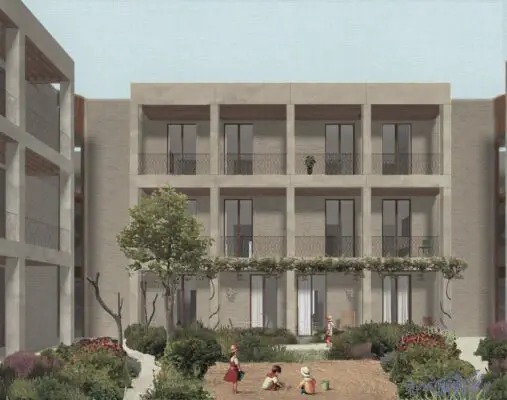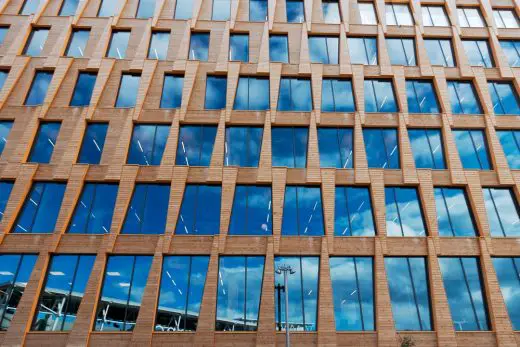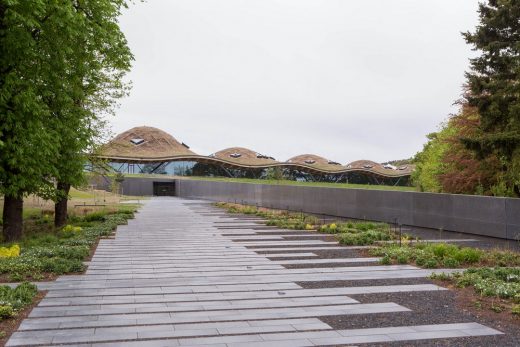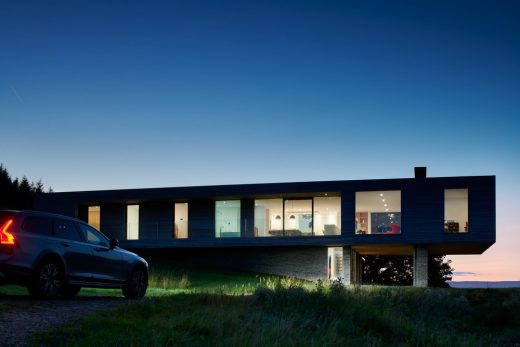UK Climate Change Policy comment, Sustainable construction design, ESG compliance, UN Sustainable Development Goals
UK Climate Change Policy News
10 October 2023
Climate policy must roll forward, not backward
Professor Peter Exley, the new Dean for the Scott Sutherland School of Architecture & Built Environment, and a former President of the American Institute of Architects:

photo courtesy of Scott Sutherland School of Architecture & Built Environment
Thought leadership from Professor Peter Exley on UK Climate Change Policy
No moral case seems strong enough to compel us all to slow global warming as a society. There is no moral bridge connecting the UN’s Sustainable Development Goals and the private sector, however enthusiastic about ESG compliance some companies might be. Massive weather events, or catastrophes such as wildfires that affect urban areas, human health, and lives are too often set aside as newsworthy accidents of geography. Progress is only possible by making a business case for a proactive climate policy, because ideological and existential predictions are often dismissed as eccentric, exaggerated, and politically motivated.
So here’s the business case.
According to the National Institute of Building Sciences (NIBS), based in the U.S, one unit of currency invested in disaster mitigation saves society six times that value. There’s a four to one benefit when construction exceeds the International Code Council’s 2015 model building codes. This means costing carbon into construction and creating net zero designs for homes and offices, that maximise public health and safety, whilst safeguarding against environmental hazards.
Think insulation, think wind preparedness, and flood proofing. Think insurability, and think returning to home, school, or work after a disaster, versus the prospect of rebuilding, or never being able to return.
Replacing fossil fueled heating with an air sourced heat pump creates a positive return on investment after only five years (not even counting the carbon cost) and over a 20-year life span saves a family thousands, or a business millions.
Even a modest survey of such facts, and observation of scenarios across the planet reveals that the UK government’s rollback of climate policy is not only ludicrous. It’s dangerous. The proposed delay to phase out new fossil fuel-guzzling cars and boilers another five years to 2035 might be in line with other European countries, but even in our post-Brexit désir to rejoin our economic friends, can we define a more aggressive pathway? Can we lead the multinational effort to decarbonise?
That future state of bliss in 2050 when we’ll supposedly reach net-zero nirvana isn’t automatic. That future state leaves no room for missteps, momentary or otherwise, yet it certainly leaves ample room for leadership—today. Now. Grassroots initiatives and leadership build a movement, and it’s leadership from the top that incentivizes investment and research, while enabling progress into an era that must be more resilient, equitable, and inclusive.
As the dean of a school of architecture in Aberdeen—ground zero in many ways for the energy transition at the heart of this 2035 proposal—I can tell you that the future is what we make of it today, not what we hope it will become tomorrow by being “pragmatic, proportionate and realistic,” in Prime Minister Sunak’s words. The expression “kicking the can down the road” doesn’t even come close to describing what we are doing to the next generation, some of whom we instruct as architects and builders to create—against all odds—healthy environments.
To be a leader in design and construction for a zero-carbon future in Aberdeen is to walk down Union Street and see the port in the distance—the gateway for the oil and gas industry in the north and home to oil and gas supply vessels and support vessels, which account for up to three-quarters of all traffic in the harbour.
Our energy sector can and should evolve. Not just to meet net zero ambitions but also to ensure we build a more sustainable future for all. As the UK’s offshore energy workforce, Powering up the Workforce published by RGU’s Energy Transition last month highlights, the UK only has a ‘goldilocks zone’ between 2024 and 2028, to sustain, develop and invest in the transferability of the offshore energy workforce into renewables. Only if we invest in forward-looking net zero and green capital projects, can we safeguard jobs and, by doing so build a more equal, stable society, with cheaper bills and healthier cities freed of pollution.
To design and build for a world dominated by fossil fuel in a place that has always existed at the heart of the industrial revolution is to realize one thing: this great energy transition is much bigger than you, or me, or any of my students. Yet, it is a transition that will not happen without individual leadership.
The Scottish Government’s Energy Strategy & Just Transition plan, had been due to be published in spring 2022 but has been pushed back to next summer, almost two years late. We need clearer direction on a ‘net zero energy system’ that can spell out how we will create affordable, secure and clean energy whilst creating jobs across the country.
One of the things we teach at my university’s school of architecture and built environment is that citizenship is a membership. It is also a mandate for action. As citizens, architects, and builders, we must continue to do the elemental work that empathy, courage, and critical thinking represent—the tenets of designing environments, as we do, for other people to live, work, learn, and play—so that we may fulfill the essential belief that society is, indeed, a hopeful place. Not a cynical place full of pragmatism and proportion, expecting the worst and mitigating risk, rather an optimistic one full of courage and determination.
And, I cannot think of a time in recent memory that has required as much courage and determination than right now during a year that has seen the warmest planet ever recorded.
My students learn to use the business case as justification and motivation for problem-solving, and to impact issues revolving around climate action. The idea of a “pragmatic, proportionate and realistic” pathway is confusing to me, and to them. They know that strengthening our commitment to green policies, not weakening them, demonstrates quantifiable, and qualitative societal, healthy, and economic benefits whatever our ideological stance.
—Peter Exley, Professor and Dean, Scott Sutherland School of Architecture and Built Environment, Robert Gordon University. Former President of the American Institute of Architects (AIA) and co-founder of the internationally recognised practice, ‘Architecture is Fun’, a Chicago-based architecture and design firm.
UK Climate Change Policy comment images / information from Inverness Architectural Association
Location: Scotland, UK
Climate Change
Climate Change Architecture
Climate Change Events in Scotland

Land Re-use and Climate Change
RGU Scott Sutherland School Architecture
Scott Sutherland School Architecture, Robert Gordon University
Scott Sutherland School Architecture

image courtesy of Scott Sutherland School of Architecture & Built Environment
Robert Gordon University Garthdee Campus
Sustainable Buildings
Contemporary Green Architecture Design – selection of posts:
Sustainable Architecture Climate Change
C40 Clean Construction Declaration

photo courtesy Anders Vestergaard Jensen, unsplash
Net Zero Carbon Buildings
Zero Carbon Buildings 2050 Report
House of Lords Zero Carbon Homes Ruling
Architecture in Scotland
Contemporary Architecture in Scotland – architectural selection below:
Scottish Architecture Designs – chronological list
Scottish Architecture News – recent selection
Macallan Distillery, Speyside, Highlands, Northern Scotland
Design: Rogers Stirk Harbour + Partners (RSHP)

photo © Simon PricePA Wire
New Macallan Distillery in Speyside Scotland
Upper Parkbrae House, Oyne, Aberdeenshire, Northeast Scotland
Design: Brown & Brown Architects

photograph © Nigel Rigden
Upper Parkbrae House, Aberdeenshire
Building Articles
New Architecture
Comments / photos for the UK Climate Change Policy comment page welcome
